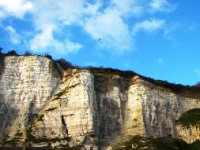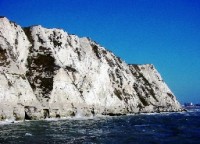If gazing out from France across the English Channel to neighboring England, one is met with a wondrous site: a wall of white stretching for miles. These white walls, seemingly painted against the blues and greens of the landscape, are a result of chalk, the primary ingredient in the soil of this part of England. Julius Caesar pointed them out in his description of the Roman invasion of Britain back in 55 B.C. Even Shakespeare refers to them in the lyric dialogue of his play King Lear.
 The White Cliffs of Dover are the most famous of the chalk landscape, due to their location; this is the narrowest section of the English Channel and as a result the cliffs can be easily seen from the French coastline. In addition, the primary ferry passage from France docks in Dover, giving tourists and visitors an excellent and up-close view of the striking cliff face. Langdon Cliffs, just to the east of Dover, and Shakespeare Cliff are two other popular cliffs in the area.
The White Cliffs of Dover are the most famous of the chalk landscape, due to their location; this is the narrowest section of the English Channel and as a result the cliffs can be easily seen from the French coastline. In addition, the primary ferry passage from France docks in Dover, giving tourists and visitors an excellent and up-close view of the striking cliff face. Langdon Cliffs, just to the east of Dover, and Shakespeare Cliff are two other popular cliffs in the area.
Behind these white cliffs are many tunnels, which were easy to excavate through the porous soil. The main tunnels were built in the Middle Ages but were enlarged in more modern times to support Britain’s defenses in the Napoleonic Wars.
 In the area surrounding Dover, towns like Deal and Sandwich welcome visitors with open arms. Besides spending the day walking the shoreline to explore the natural wonders and admiring the sweeping views, one can spend the day in the water enjoying water sports or a boat trip. The area is full of historic castles as well as many well-preserved ancient Roman fortifications. And golfers have plenty of options for a game or two. There is even a chalk grassland that has been described as “Europe’s equivalent of a tropical rainforest”. To see it all, a popular method of travel is to tour the entire area on bicycle; otherwise it is best to rent a car.
In the area surrounding Dover, towns like Deal and Sandwich welcome visitors with open arms. Besides spending the day walking the shoreline to explore the natural wonders and admiring the sweeping views, one can spend the day in the water enjoying water sports or a boat trip. The area is full of historic castles as well as many well-preserved ancient Roman fortifications. And golfers have plenty of options for a game or two. There is even a chalk grassland that has been described as “Europe’s equivalent of a tropical rainforest”. To see it all, a popular method of travel is to tour the entire area on bicycle; otherwise it is best to rent a car.
For more information and further ideas on touring this wonderful region, visit the official tourism site White Cliffs Country .


Comments